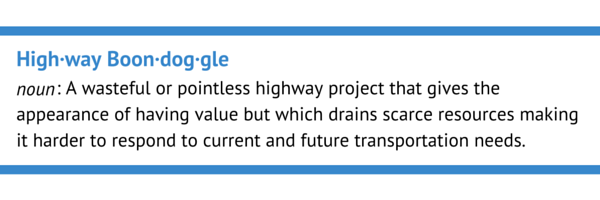Red Light for Highway Boondoggles
Across the country, states are poised to spend billions of dollars on wasteful highway projects -- new construction and expansions -- exhausting limited funds that could be better spent on repair and maintenance or put toward critical investment in transit, biking, and pedestrian options that better meet current and future needs.

Across the country, states are poised to spend billions of dollars on wasteful highway projects — new construction and expansions. Our new report, Highway Boondoggles 2, looks at 12 highway projects across the country that reflect a particularly troublesome mix of skewed transportation priorities, minimal benefits to local communities, and in some cases a huge price tag to boot. Together, these projects are expected to cost at least $24 billion — exhausting limited funds that could be better spent on repair and maintenance or put toward critical investment in transit, biking, and pedestrian options that better meet current and future needs.
These highway expansion projects are being planned against the backdrop of several pertinent trends that make their construction questionable.
First, the nation and states are strapped for transportation cash. Traditional sources of funding for transportation (namely the gas tax) aren’t covering the amount of investment needed. In fact, the federal gas tax isn’t tied to inflation and hasn’t been raised since 1993. Increasingly, the federal government is turning to general fund transfers to make up the balance rather than finding a long-term, sustainable funding solution. In 2014 alone it cost $22 billion in general fund dollars to make up the difference, and covering the shortfall through 2025 is projected to cost another $147 billion. Given these fiscal constraints, states must more wisely consider which projects get the nod.
Second, long-term transportation behavior is changing. In 2014, the most recent year for which annual data is available, Americans drove as much per person as we did in 1997, reflecting a decade-long trend of less driving. With gas prices declining to levels not seen in years, and cheap money making buying vehicles easier, the last few months have appeared to show a slight uptick in driving after years of decline. Yet, the reasons for the initial decline in driving — an aging (and retiring) workforce, record transit use, changing preferences and lifestyle choices (especially among millennials) — still hold true. Thus, in the long-run, it remains likely that driving will ultimately reflect levels more akin to the last few years than the last few months.
Third, Americans increasingly want to live in areas where they don’t need to drive but can walk, bike, or take public transportation. That’s particularly true for millennials, America’s largest generation which drove 23 percent fewer miles in 2009 than they did in 2001. Young people are also waiting longer to get driver licenses, if they do at all: between 1983 and 2010, the percentage of 19-year-olds with a driver’s license fell 17 percent.
Finally, public transportation use is at record highs; in 2014, transit ridership in the U.S. hit its highest point since 1956. New mobile technologies have also made using existing public transit easier and made new forms of transportation like bike-shares and car-shares more accessible for more users. More non-driving options make it easier to own only one car, or none at all.
It’s clear that long-term transportation habits are changing,1 but our spending choices aren’t reflecting that. From 2009-2011, the latest years for which data is available, states collectively spent more than half of their available transportation money to expand just one percent of the current road system, while maintenance on the other 99 percent was merely a secondary priority.2 Aging roads and bridges across the country need to be rebuilt, and the longer we wait to do so, the more expensive and painful the fix. Despite the fact that more people are opting to use public transit, and despite the fact that public transit decreases harmful emissions that make us sick and contribute to global climate change, those projects still get the short stick – by a lot! In the five-year federal transportation funding bill passed last December, just 20 percent of federal transportation money was reserved for transit while 80 percent was dedicated to highways. States can use some of this money for transit, biking, and/or pedestrian projects rather than highways at their discretion, but they rarely do so.
States often argue that new and wider highways are needed to combat growing congestion: if we only increase the number of lanes, cars will travel faster. However, that is not true. A growing body of research3 has confirmed that building bigger roads doesn’t reduce traffic — like many of our boondoggles purport — but may actually make it worse in the long-run, a phenomenon known as “induced demand.” While adding lanes to a highway may appear to reduce traffic somewhat initially, as people take the new highway capacity into account while making travel plans, traffic will increase until congestion again limits the volume.
Beyond the national trends, the specific case against each highway boondoggle practically writes itself. The projects we looked at in our most recent report on the matter, Highway Boondoggles 2, are but a sampling of some of the worst projects across the country. Sadly, this list is not exhaustive. A few of the terrible projects include:
- I-95 widening, Connecticut, $11.2 billion – Widening the highway across the entire state of Connecticut would do little to solve congestion along one of the nation’s most high-intensity travel corridors.
- Tampa Bay Express Lanes, Florida, $3.3 billion – State officials admit that a decades-old plan to construct toll lanes would not solve the region’s problems with congestion. Instead, it would displace critical community job-training and recreational facilities.
- State Highway 45 Southwest, Texas, $109 million – Building a new, four-mile, four-lane toll road would increase traffic on one of the most congested highways in Austin, and increase water pollution in an environmentally sensitive area critical for recharging an aquifer that provides drinking water to two million Texans.
- San Gabriel Valley Route 710 tunnel, California, $3.2 billion to $5.6 billion – State officials are considering the most expensive, most polluting and least effective option for addressing the area’s transportation problems: a double bore tunnel.
- I-70 East widening, Colorado, $58 million – While replacing a crumbling viaduct that needs to be addressed, Colorado proposes wasting millions of dollars widening the highway and increasing pollution in the surrounding community.
There is much more detail to be found on all 12 boondoggles in the full report, but taken with the national background explained above, it’s hard to see how states could still be considering (let alone proposing!) boondoggles like these. Our money would be better spent maintaining, repairing, or rebuilding the crumbling infrastructure we’ve already built.
While it’s important to shine a light on these projects, we’re also working to make sure that they don’t become a reality. In September 2014, we released Highway Boondoggles, the first of these reports, which identified 11 different highway boondoggles. Today, three have been put on hold, cancelled, or are undergoing significant revision while 5 are still under “study & review”. In order to stop highway boondoggles, we need you. Local opposition has a long history of stopping detrimental highway projects dating back to the 1950s. Add your voice today to help stop these wasteful projects and make sure states use our transportation money to maintain our existing infrastructure and give travelers more options with public transportation, waking, and biking.
1 See U.S. PIRG’s series of reports on changing transportation trends including, “Moving Off the Road,” August 29, 2013; “A New Way to Go,” October 1, 2013; “Millennials in Motion,” October 14, 2014.
2 Smart Growth America, “Repair Report 2014,” March 2014.
3 Handy, Susan, National Center for Sustainable Transportation, “Increasing Highway Capacity Unlikely to Relieve Traffic Congestion,” October 2015.
